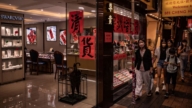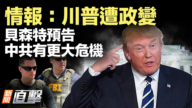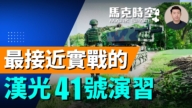【新唐人2012年12月13日讯】美国《华尔街日报》11号刊登“图说中国的失业率和贫富差距”文章,文章指出,一份最新的调查报告,彻底打破了有关中国经济的传统看法。下面就来看看这份调查报告是怎么说的:
中国西南财经大学、美国德州农工大学(Texas A&M University)教授甘犁:“在去年(2011年)8月、和今年(2012年)6月,对中国的8,000户家庭作了两次调查,调查表明,今年中国的经济放缓,对劳动力市场的影响,大于人们原先所想。”
甘犁的调查发现,今年6月份,中国城镇失业率是8.05%,仅略高于去年8月份的8%。但这差不多是国家统计局发布的官方登记失业率4.1%的两倍。
《六四天网》义工蒲飞:“它的4.1%是从那个登记失业人口上算的。中国没法算,因为中国没有一个明确的所得税申报制度,失业(人口)应该从你每个月是否有正常收入来计算,但是你缺乏这个所得税申报制度的话,你这个东西完全没法算。”
而美国“南卡罗莱纳大学艾肯商学院”经济学教授谢田博士分析指出,中共当局不只失业率造假,几乎所有数字都是假的。
美国经济学教授谢田:“因为中共不光是失业率造假,它在GDP上也造假,在基尼指数上也造假。就是为了营造一个经济繁荣的假象。而经济如果要是繁荣的话,你失业率一定不能高。你失业率太高的话,你怎么能是社会繁荣呢?怎么能够用来欺骗外资,吸引外资呢?所以这个数字从这个逻辑上推理,也是假的。”
报导说,甘犁所进行的失业率调查,是亲自派遣做研究的学生深入城乡,进行直接家访,克服官方之前的障碍。
而调查报告指出,在总人口当中,大学毕业人群是失业率最低的群体,他们的失业率只有3.6%。
谢田:“如果这个社会只有4%的失业率的话,那这个大学生应该很容易找到工作。中共说它那个经济增长是10%,失业率只有4%的话,那那个经济增长连带人就业,那中国肯定大学生都不够用。”
根据甘犁的调查,中国的“基尼系数”为0.61,显示,已超出“社会分配不公的危机临界点”0.4甚多。另外,中国收入最高的20%的人控制着68.4%的收入,收入最低的20%的人仅控制着0.5%的收入。
他的调查还显示,2011年有一半以上的中国家庭收入非常低,实际上没有存下什么钱。相比之下,中国收入最高的10%的家庭挣钱很多,即便是在享受奢侈生活方式的同时,仍有大量的钱可以存入银行,占存款总额的74%。
谢田:“大家都知道失业率很高,经济很糟糕的话,人们就会互相鼓励,会更加…协力反抗中共政权的一个动力。它营造这种假象,让人觉得可能其他人还不错,只有我不好,只有我找不到工作。一贯的欺骗民众,欺骗国际社会。”
根据《六四天网》在第一线所收集的数据,中国的农村人口有2千万人因为“征地拆迁”导致失业。
蒲飞:“这2千万人的失业,肯定就会带来一个完全的、整体的社会动荡的一个风险存在。所以,到现在为止,你要更改失业率,肯定要给别人一个能生存的制度,你这个失业率才会有所变化,如果你还是这个政策制定下去,我看不会有什么变化。”
甘犁说,政府的首要任务应该是收入再分配,将更多的可支配收入放到中国广大家庭手中。而日前一份递交中共中央和国务院的《关于社会稳定、和谐状况调查研究》说,社会长期分配不公、贫富悬殊两极分化,加上官场贪污腐败、党群关系处于紧张、官民对立情绪恶化、警民冲突频发等,形成了社会深层次、积压难解的不稳定因素。
采访/李莲 编辑/周平 后制/葛雷
Survey Reveals China’s True Unemployment Issue
On December 11th, Wall Street Journal published an article
titled,"Charting Chinese Unemployment, Inequality."
The article stated, “A new survey turns the received
wisdom about China]s economy on its head."
Let]s have a look at what more the article tells us.
Gan Li, professor at US Texas A&M University and China
Southwestern University of Finance and Economics,
carried out two surveys of 8,000 Chinese households
in August 2011 and again in June 2012.
The surveys suggest that the slowdown of China’s economy
since this year has more influence on the labor market than previously expected.
Gan’s survey finds that China’s urban unemployment rate
was 8.05% in June 2012, which is slightly higher than the 8% in August 2011.
But it is still almost twice the official unemployment rate
of 4.1% announced by the National Bureau of Statistics of the Chinese Communist Party (CCP).
Pu Fei (volunteer at 64tianwang.com): “The number of 4.1%
comes from statistics of registered unemployed population.
However, this does not work correctly because there’s
no well-regulated income tax return system in China.
The unemployment rate should include anyone
who does not have a regular monthly income.
Without an income tax return system
it is simply impossible to obtain accurate data."
Xie Tian, Professor at the Aiken Business School at
the University of South Carolina, commented on the topic.
Xie remarked that not only the employment rate is forged,
almost every officially published by the CCP number is false.
Xie Tian (Economics Professor, US):"Besides unemployment
rate, CCP also forges numbers such as GDP and Gini index.
All these are to create illusions of an economic prosperity
because if your economy is good, you should not have a high unemployment rate.
If your unemployment rate is very high, how can you
announce that you have a flourishing economy?
How can you attract more foreign investments
by deceiving them?
Even such a logical analysis can tell
that the number is probably not true."
The report mentioned that Prof. Gan’s survey was carried
out by his students who made direct home visits to urban or rural residents.
This overcomes the flaws of the official statistics.
The survey also shows, college graduates’unemployment
to be 3.6%, which is the lowest in all population groups.
Xie Tian: “If the unemployment rate is only 4% for the
whole society, then it should be fairly easy for the college students to find a job.
The CCP officially said the economic growth rate is 10%
and unemployment rate is 4%.
If those numbers are true, the economic growth will create
many more job opportunities which should lead to a shortage of college graduates."
Prof. Gan’s survey found China’s Gini coefficient to be 0.61,
which is much higher than 0.4, the critical point indicating significant social inequality.
In addition, China’s top 20% controls 68.4% of the total
national income while the lowest 20% only controls 0.5%.
Other statistics reveal that over half of Chinese families had
relatively low yearly incomes in 2011 with little savings left.
In comparison, China’s top 10% reaches families had earned
so much money that they contributed 74% of the total bank deposits, despite their luxurious life styles.
Xie Tian: “Everyone knows that a high employment rate
and bad economy will lead to more sympathy between civilians and better unity against the CCP’s regime.
Therefore, the CCP tries to create an illusion
by forging the statistics.
This can have the effect of making you feel it is your fault
that you are not able to find a job, as others are fine.
It just constantly tries to deceive the Chinese people
and the global society."
According to first-hand statistics by 64tianwang.com,
20 million of rural Chinese had lost their jobs because of land acquisitions and house demolitions.
Pu Fei: “The survival of those unemployed people will
inevitable lead to a higher risk of a wide social disorder.
Therefore, you have to provide people with ways to make
a living, if you want to make the unemployment rate drop.
If the current policies keep going like this, I"”
Gan Li remarked that the primary task of the government
should be the redistribution of the income.
That is, giving most Chinese families
more disposable income.
Instead, a recent report titled,"An Investigation on Social
Stability and Harmony" was submitted to the CCP Central Committee and State Council.
The report reveals that there have been deep-rooted,
abstruse problems leading to social instability.
And that they result from long-term unfair income
distribution, serious social inequality, and corruption,
in addition to high tension between political groups, intense
antagonism, and frequent conflicts of police and civilians.






























